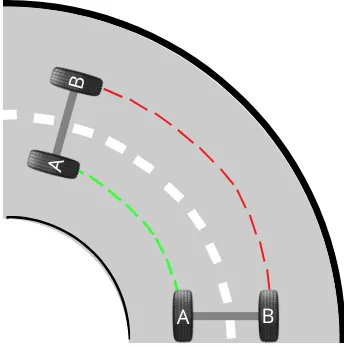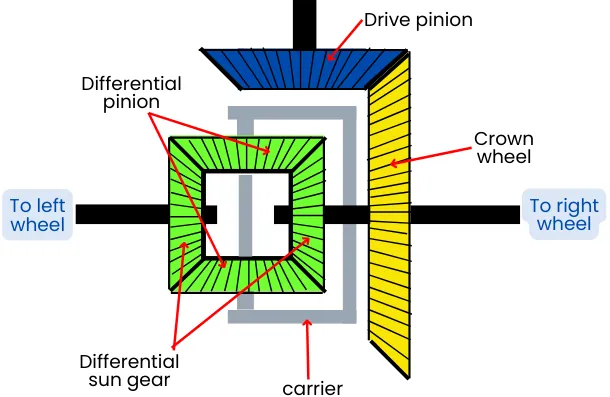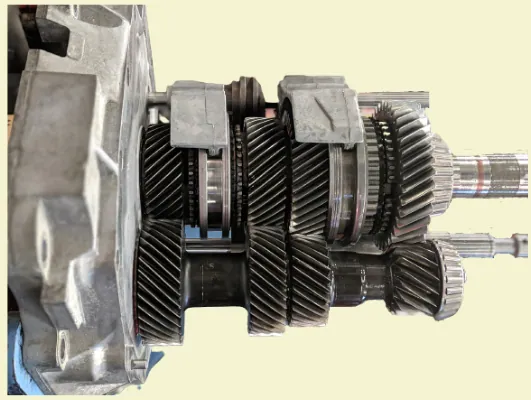One of the key difference between the differential and transmission is that the differential splits the power to both wheel half shafts and also helps to rotate both wheels at different speeds while the transmission helps to obtain different speed ratios in the vehicle.
In this article, we’re going to discuss:
- Differential:
- Transmission:
- Difference between Differential and Transmission:
- FAQs:
Differential:
The differential in automobiles helps to splits the power from the final drive to both wheel’s half shafts as well as it allows both the half shafts to rotate at different speeds.
As shown in the below figure, while moving onto the curve road, both of the wheels have to cover different distances. It means that the outside wheel has to cover more distance in comparison with the inner wheel. Therefore without a differential, it will become difficult to steer the car on curved roads.

The differential unit helps to create a speed difference between both wheels. So that the vehicle can easily turn on the curved road.
The below figure shows the basic construction of the differential unit. It generally consists of a crown wheel, differential sun gears, differential pinions, carrier, drive pinion, etc.

Transmission:
The transmission in the automobile helps to obtain different gear ratios manually or automatically.
The different gear ratios can be selected manually with the help of a lever or they can be selected automatically.

The engine generally provides lower torque at lower RPM and higher torque at higher RPM. But the requirement of the torque and speed of the vehicle varies as per the driving situation.
It means that the car running on the highway requires higher speed and less torque and while moving uphill it requires more torque at less speed.
But the only engine can’t meet the different torque and speed requirements for the different driving situations. The transmission unit consists of multiple gears meshed in a particular manner, which helps to obtain different gear ratios. It helps to obtain various torque and speed combinations.
Difference between Differential and Transmission:
| Sr. No. | Differential | Transmission |
|---|---|---|
| 1 | It helps to rotate the wheels (right and left) at different speeds while moving on a curved or bumpy road. | It gives different combinations of speed and torque at the output shaft. |
| 2 | It is connected between the final drive and wheel half shafts. | It is connected between the clutch and propeller shaft (Drive shaft). |
| 3 | It provides a single fixed reduction ratio. | It helps to provide different speed ratios. |
| 4 | It can’t stop the further transmission. | The transmission provides neutral gear which isolates the engine from further components. |
| 5 | It doesn’t require manual or automatic operating. | The gears need to be shifted manually or automatically. |
| 6 | It is not required in two-wheelers. | It is also present in two-wheelers. |
| 7 | It has two output shafts for both side wheel half shafts. | It has a single output shaft. |
| 8 | The vehicle may have one differential unit (in two-wheel drive) or two differential units (in four-wheel drive). | Generally, the vehicle requires a single transmission unit. |
| 9 | It doesn’t require an oil pump for lubrication. | Some of the transmissions require an oil pump for lubrication. |
| 10 | The input and output shafts are perpendicular to each other. | The input and output shafts are parallel. |
| 11 | It mostly uses spiral bevel gear or straight bevel gear or hypoid gear. | It uses spur/helical gears or planetary gears. |
FAQs:
-
Are the differential and the transmission the same thing?
No, the transmission and differential are different units and perform different functions while transmitting power in a vehicle.
-
What links the differential and the transmission?
In 2-wheel drive vehicles the differential and transmission are connected by a propeller shaft while in 4-wheel drive, they are connected with the help of a transfer case and propeller shaft.
Related article: